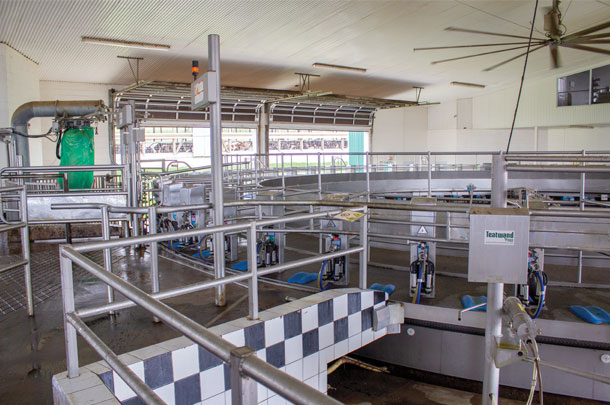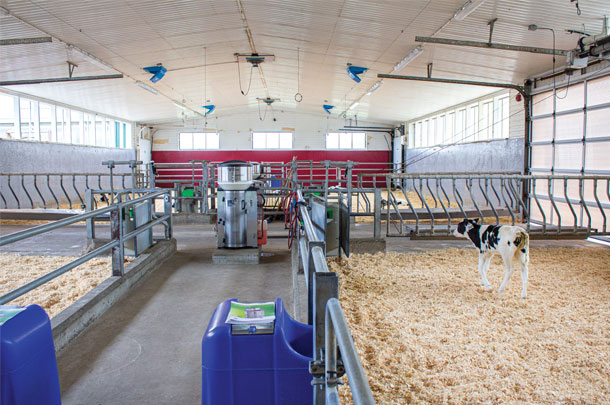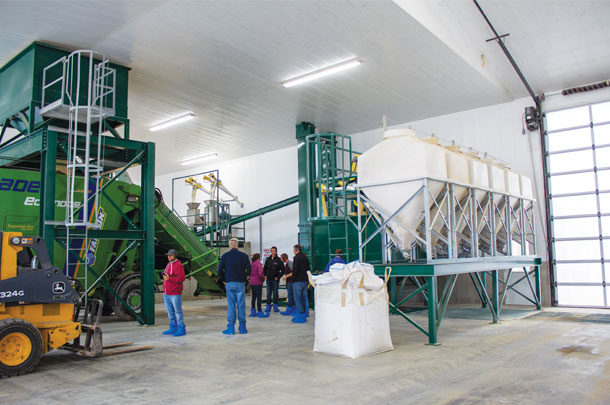They purchased a bank barn with 45 cows in Baden, Ontario, and quickly fitted the farmstead with a double-eight parlour and freestall barn.
These buildings are still in use today, but in different capacities. More expansion has also taken place to accommodate the farm’s 460 cows, and automation has been added to reduce the farm’s dependency on labour and enhance consistency.
In 2009, Kees and Tineke Hogendoorn, along with their son Kees Hogendoorn Jr. and his wife, Amanda, built a new 60-stall rotary parlour. It can handle 300 cows per hour and milking is done in less than two hours, three times a day.
Two years ago, they installed an automated prepping robot to sanitize and stimulate the cows prior to manual milking unit attachment.

“It saves one person,” Kees Hogendoorn Jr. says.
It spends six to eight seconds dipping and stimulating each cow. “Milk letdown is more consistent and faster. That speeds up the whole milking,” he says.
From there, one person dries and attaches units to four cows and repeats. Another person monitors the other side of the parlour.
The herd averages 35 litres of milk per cow at 4% butterfat. The somatic cell count (SCC) is under 200,000, which he says didn’t change much with the new automated dipping system.
The parlour is also equipped with an inline milk analyzer to monitor butterfat, lactose and protein. They find it particularly helpful for catching ketosis and have set the parameters higher for fresh cows up to 90 days in milk. “Those cows are critical; if they go down, production goes down,” Hogendoorn says.
With the early detection, he finds they don’t do a lot of glycol treatments.
An automated sort gate pulls cows after each milking for treatments and lameness. Footbaths are used twice a week, and a hoof trimmer comes every other week. Cows are also sorted for breeding based on activity readings. Herd health checks are done once a week.
During the milking, Hogendoorn and his father breed and treat cows while his mother tends to the special-needs cows housed just behind the holding area.
They have a single-five parlour in place for this group. Fresh cows are milked before the treated cows. They stay here for two weeks after calving before moving to the first-lactation group or high-production group. This parlour is also used for dry-off with a selective dry cow treatment program in place.
The remainder of this barn holds close-up heifers and close-up dry cows. Dry cows are on a sand pack. The farm’s sand recycling system keeps an abundant supply, and it is good for traction, he says.
The majority of the milking cows are housed in the freestall barn next to the parlour facility. Both barns are sand bedded and were converted to a flush system when the rotary was built. A year ago, they installed a sand separation system and opted for mechanical over gravity flow because they knew it would keep operating through the winter.
The system works 24 hours a day, seven days a week. Sand is stockpiled from the bedded pack and fed into the system each day to keep it full.
Hogendoorn says with everything inside a building, the tasks can be planned out and are more user-friendly. It takes 30 minutes to move sand in the morning and 15 minutes at night.
With the mechanical separator and a small sand lane to collect fine sand, they are able to recover 95% to 98% of sand and can use it again for bedding after two days. Barns are bedded at least once a week.
Once the sand is removed, the manure goes through a separator. The liquid portion goes to the flush tanks and the thicker solids to the manure pit.
An automated feed mill on-farm also makes the feeding process more planned and user-friendly.
They have seven bunker silos for forages and store commodities including soybeans, soymeal, canola, corn, bicarb, limestone and salt in eight outdoor bins. Minerals are kept in bins indoors.
The on-site feed kitchen enables them to buy commodities in bulk and schedule the times batches are made. Mixing can be done at night and as feeding continues. They are able to feed seven to eight different rations in just under two hours.
Labour savings was one reason for installing the automated system in place of the old commodity shed. Another reason was to improve the accuracy and consistency of each mix, which resulted in more consistent milk production.
To complete the feeding system, the Hogendoorns use a self-propelled TMR mixer and automated feed pushers in the barns. The old double-eight parlour was converted for group calf housing. Feeling like the stocking density was too high in the groups, the Hogendoorns decided to build a new calf barn with individual suites. The group housing is still used as a nursery barn.
“We start the calves in the group. It saves a lot of time,” Tineke Hogendoorn says.
The first two days, calves receive six feedings of 3 to 3.5 litres of colostrum; then they are started on the automated feeder with never more than eight calves per pen.
Sixteen calves are transferred at a time to the new barn and fill one row of individual suites there. Both of the group pens are cleaned, and shavings are reused for the 3-month-old calves. The pens are pressure-washed with foam disinfectant and left empty for one week to dry.
The group feeders are equipped with automated pump hose cleaning and antibacterial nipples that are changed once a day and cleaned.
With training on the autofeeder from a young age, the calves adapt quickly to the automated rail feeding system in the new barn. The pens are filled with the oldest calf closest to where the feeder starts.
They receive up to 10 litres a day, five times a day. At first, the calves were getting 2.5 litres per feeding, but they found the extra half-litre took too long to consume. Quite a few calves began playing with the nipple and spilling it. With just 2 litres per feeding, they don’t see that happening nearly as much.
Calves are gradually weaned over 21 days with a total of 60 days on the feeders.
From the suites, calves move to group pens in the same building. At 6 months old, they move to the original dairy barn. When they are 12 months old, they move to the first freestall barn, built in 1997. It is the only barn with a slatted floor and mats in the stalls.

Once in the breeding group, they are fitted with pedometers, and breeding starts at 14 to 15 months old. They genomic test the heifers and use sexed semen on the first service. Over 60 days pregnant, the pedometer is removed, and the heifer moves to another group.
The farm has three full-time employees and up to four foreign temporary workers. “People can have off when they want. In the winter, the [foreign workers] can go home for Christmas and New Year’s, and we make it work,” Kees Hogendoorn Jr. says.
Even though the farm looks different, the Hogendoorn family has maintained the use of the original buildings and found ways to make the work easier and more consistent. ![]()
PHOTO 1: An automated feed mill makes the feeding process more planned and user-friendly.
PHOTO 2: Automated prepping and post-dipping robots on the 60-stall rotary have reduced labour needs for milking.
PHOTO 3: The old double-eight parlour and holding area was converted to group calf housing and is now used exclusively as a nursery barn. Photos by Karen Lee.
The Hogendoorn Dairy was one of three stops on the Progressive Dairy Operators’ Farm Show Bus Tour in September.

-
Karen Lee
- Editor
- Progressive Dairy
- Email Karen Lee










